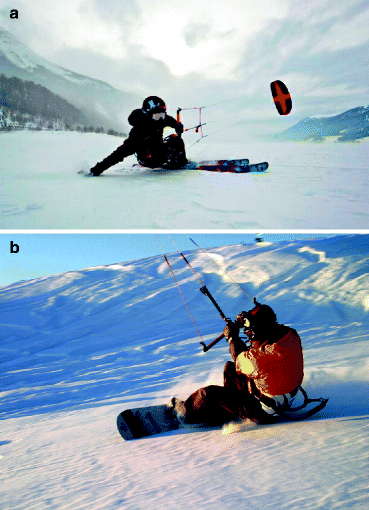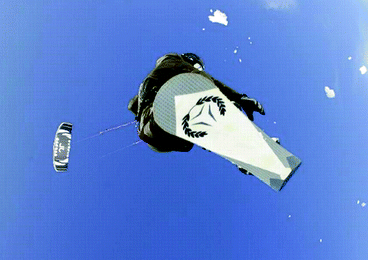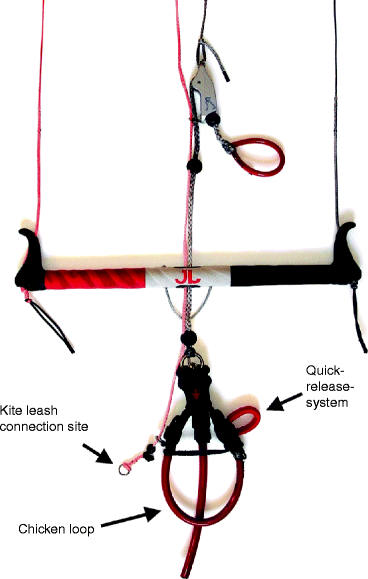Fig. 8.1
(a) Kite surfing allows for high velocity converting the propelling force of the kite into high speed on water. The kite forces are transferred to the kiter through the central lines and the belt harness. Spectacular jumps are possible, transforming the wind power into vertical lift power. (b) wave kite surfing. The surfer uses both the wind (kite) and the wave to increase performance (Courtesy of Ronen Topelberg)
The idea of practicing kite surfing during the winter season in areas with sufficient snowfall and favorable wind conditions seemed to be a natural progression. Making use of the same principle of transforming the wind energy into a propelling force, snow kiters are able to reach high velocities (Fig. 8.2a, b), go uphill, and perform spectacular jumps (Fig. 8.3) because of the vertical lift created by the kite. The most evident differences are the skis or snowboard they use to move on the snow and design of the kite. In contrast to kite surfers, who use tube kites with inflatable air chambers, snow kiters prefer foil kites with air cells to provide it with lift and a fixed bridle to maintain the C shape of the kite. Snow kiting is practiced all around the world, wherever you can find snow and enough wind. Many people practicing Kite surfing during the summer successfully started trying to snow kiting on snow-covered planes or frozen lakes by just combining the kite that they use for kite surfing with a snowboard or skis. Obviously, as the number of snow kiters grew, it did not take too long that special snow kite equipment was developed.



Fig. 8.2
(a) Snow kiting works according to the same principles as kite surfing. The skis used are freestyle skis with bidirectionality. The official high-speed world record for snow kiting is 111.2 km/h held by Hardy Brandstoetter. (b) Snow kiting is performed using snowboards, as well. The propelling force generated by the kite is transformed over the harness to the kiter (Courtesy of Hardy Brandstoetter)

Fig. 8.3
Snow kiting using boards is similar to kite surfing. The freestyle design of the board allows for bidirectionality. The enormous wind forces allow the snow kiter to reach high-speed velocity (Courtesy of Hardy Brandstoetter)
The Equipment Used: Essential and Safety Requirements
Kite Surfing
To practice kite surfing, a kite, board, harness, and other basic equipment are needed. The equipment has to be adjusted to the rider’s weight, his skill level, and to water and wind conditions.
Board
Three different types of kite boards have to be distinguished: “twin tips,” mutant boards, and directional surf-style boards. In contrast to conventional surfboards, all three types do not have any significant buoyancy, which develops hydrodynamically during the ride. In dependence on skill level, wind force, body weight, and kite size, the board dimensions have a length between 120 and 165 cm and a width ranging from 26 cm up to 45 cm. Twin-tip boards are similar to wakeboards showing bidirectionality. They are easy to learn and meanwhile became the most popular boards under both beginners and experts. They are symmetric regarding outline, shape, and order of the foot straps, allowing for maintenance of the foot position when changing the direction of surfing. Mutants represent a hybrid form between twin tips and directionals. Basically, it is designed for directional riding, but due to two fins at the bow, bidirectional surfing is possible. Finally, the directional board represents the mother of the kite surfing boards. It was taken from surfing and can be ridden only in one direction because of lacking fins at the bow and the spired shape. To change the direction, the foot position has to be changed as well.
Kite
Two major forms of power kites are available at the market. Leading edge inflatable (LEI) kites (known also as inflatables or C-kites) are produced from ripstop polyester with an inflatable main plastic tube at the front edge and separate smaller tubes (struts) perpendicular to the main bladder to form the chord of the kite. The air chambers are inflated before starting with a pressure of 0.4 to 0.6 bar. The air tubes save the shape of the kite and prevent sinking of the kite once dropped in the water. This type of kite is favored by most of the kiters due to its quick and direct response to the rider’s inputs, easy relaunchability, and stability. The next generation of LEI development was the flat LEI or bow kite. The C-shape profile was lower, and the main front tube had bowed ends, which gave the name to this type of kite. The most obvious advantage is the possibility to change the kite’s angle of attack and to depower it completely, which represents a decisive key safety feature rendering it suitable for beginners. Hybrid or SLE (supported leading edge) kites are characterized by several lines fixing the front tube, achieving a high depower efficiency associated with improved cruising characteristics due to direct kite control. In 2007, delta-shape kites were introduced into the market. They are similar to bow kites and have four to five lines. The depower efficiency is extremely high, and the easy relaunchability makes them attractive for beginners.
In contrast to LEI kites, foil kites are similar to a paraglider and are suitable mostly on land, that is, for snow kiting. Foil kites with closed cells can be used also on the water, keeping the air inflated for longer time due to an inlet valve mechanism making relaunching the kite much easier. Usually, three lines are sufficient to control the kite; however, some have four.
The size of the kite depends on the wind force and on the weight of the rider. Usually, kite sizes range from 9 to 12 m2. It always has to be kept in mind that doubling of the wind speed results into a fourfold increase of the kite power.
Lines and Bar
A typical kite has four lines with a length of 24–30 m. The lines that originate from the center part of the kite run medially through the handlebar and are connected to the kite surfer’s harness through the so-called chicken loop. They provide the necessary propelling force to put the kite surfer into motion. The two lines, each originating from one edge of the kite, are firmly attached to the edges of the handlebar (Fig. 8.4). They enable the kite surfer to control and guide the kite by pulling on one end of the bar and pushing the other. A safety system comes as standard with most kites nowadays and represents an absolute essential. In case of an accident, the kite surfer can detach her or his harness from the chicken loop by activating the so-called quick-release system. When activating this system, the “chicken loop” releases the hook of the harness and the kite surfer only remains attached to the kite by a so-called kite leash which completely depowers the kite and does not produce any pull. The “depower” system reduces the kite’s angle of attack to the wind, thereby catching less wind and reducing its propelling power. The safety leash enables the kite surfer to disconnect himself completely from the kite in exceptional situations.


Fig. 8.4
The handlebar allows the kiter to control and depower the kite. The central lines transfer the kite power to the kiter, who is attached by the so-called chicken loop to the harness. The two main safety tools are the quick-release system for immediate disengaging of the chicken loop from the harness in case of emergency and the kite leash, which in case of activation of the quick-release system, completely depowers the kite and does not produce any pull (Courtesy of Hardy Brandstoetter)
Other Equipment
Aside from the board and kite, there is an armory of equipment that athletes need to have before getting out on the water, independently from the place where they ride. A harness is absolutely essential. It is generally available in two styles. The belt harness fits around the waist, and the seat harness is a full crotch fit. The seat version reduces the center of balance and pull, making boarding more stable. A further absolutely equipment essential is the wetsuit, available in thicknesses from 3 to 7 mm, depending on how cold it is likely to be. They come in different leg and arm lengths with a shorty suit in 3 mm for warm-water riding. Even in tropical waters, wetsuits can protect the kite surfer from crash landings and hypothermia. Flotation or buoyancy is mandatory with some belt-style harnesses now incorporating buoyancy. Another essential requirement is a helmet. There is no excuse for not wearing one since the risk for sustaining a head injury amounts to 15 % for these extreme sports. Furthermore, the use of a board leash is recommended. It attaches the board to the surfer’s ankle or rear of the harness via a Velcro strap fastening and an approximately 3-m-long vinyl cord in order to avoid board loosening. A clear disadvantage is the increased risk of getting injured by the fixed board.
Prior to start, wind conditions should be analyzed. The wind strength influences the kite size and/or line length. In order to get adequate information, other kite surfers can be asked for the wind and sea conditions. However, an anemometer for self-measurement of the wind power should make part of the equipment.
As with any sports equipment, material failures may occur, and the kite surfer should be prepared for those cases. A puncture repair kit for the inflatable tubes represents an essential part of the equipment, as well as spare flying lines, a spare control bar, spare fins for the board, spare straps or bindings, and a spare harness.
Snow Kiting
Typically, snow kiters use regular freestyle snowboards and skis to practice snow kiting. Both, skis and boards, enable the snow kiter to run bidirectionally and to perform quick direction turns. Regarding the kite, however, special designs for use on snow are available. Kite surfers use so-called tube kites, which are kept in shape by an inflatable air chamber that prevents the kite from sinking in case it hits the water. Snow kiters, in contrast, tend to use the cheaper foil kites, which occupy less space when stored in a backpack and are easier to start and land. The kite sizes vary from 2 to 20 m2, and the length of the lines ranges from 20 to 30 m. Lines, handlebar, and safety system including quick-release system and kite leash are the same as for kite surfing.
Further safety equipment often used are helmets (92 %) and spine protectors (51 %), while shoulder, hip, wrist, elbow, and knee protectors are more scarcely used.
Injury and Fatality Rates and Specific Types of Injury Related to Each Sport
Kite Surfing
The conversion of wind energy into speed and vertical lift power enables the kite surfer to perform fast runs and high jumps. The actual speed record is about 55.6 knots (102 km/h) held by the US-American Rob Douglas in 2010, reached at the Lüderitz Speed Challenge in Namibia. The highest documented jump reached 10 m (unofficially 48 m) and the longest, 250 m. In July 2007, Jessie Richman performed a 22-s jump in the Golden Gate, Bay of San Francisco, which is the longest jump documented to date. Enormous, often unpredictable natural forces expose the kite surfers to an increased risk for injuries and render kite surfing and snow kiting extreme sports.
The first report in the literature regarding injury types and rates among kite surfers was published in 2001 by Kristen and Kröner [1]. They reported retrospectively about the World Cup competition on the largest continental lake in Austria. The most severe injury in this series was a cervical spine fracture with a tetraparesis. However, most of the injuries were minor.
Similar injury rates and patterns have been reported by Petersen et al. in a more comprehensive survey study [2]. Retrospectively, 72 kite surfers have been analyzed during the 2001 season using a questionnaire. Injuries have been classified as severe in terms of polytrauma; moderate, requiring medical assistance; and minor, without the need for medical assistance. Thirty-one injuries have been registered, 5 moderate and 26 minor injuries resulting in an incidence of moderate kite injuries of 1 per 1,000 h and 5 per 1,000 h for minor injuries, respectively. In addition, kite injuries have been registered from surrounding trauma centers resulting in one polytrauma and three further moderate injuries. Most of the moderate injuries have been fractures involving the radius, fifth metacarpal, ankle, patella, or ribs. The most frequent mechanism leading to injury was a direct trauma against objects such as stones and boats lying on the beach. The most common reason for injury was lost of control over the kite on or close to the beach due to technical mistakes of the kite surfer, oversized kites, or the unfavorable wind conditions as onshore wind or gusts.
Stay updated, free articles. Join our Telegram channel

Full access? Get Clinical Tree








